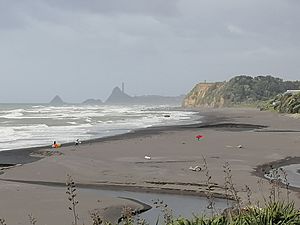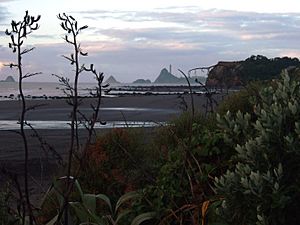Ōakura facts for kids
Quick facts for kids
Ōakura
|
|
|---|---|

A view of Ōakura Beach looking toward New Plymouth
|
|
| Country | New Zealand |
| Region | Taranaki |
| District | New Plymouth District |
| Ward | City |
| Area | |
| • Total | 1.68 km2 (0.65 sq mi) |
| Population
(June 2023)
|
|
| • Total | 1,730 |
| • Density | 1,030/km2 (2,667/sq mi) |
| Time zone | UTC+12 (NZST) |
| • Summer (DST) | UTC+13 (NZDT) |
| Postcode(s) |
4314
|
| Area code(s) | 06 |
Ōakura is a small township in New Plymouth District, Taranaki, in the western North Island of New Zealand. It is located on State Highway 45, 15 kilometres south-west of New Plymouth. Ōkato is 12 km further south-west. The Oakura River flows past the town and into the North Taranaki Bight. To the south is the Kaitake Range, part of Egmont National Park.
The Oakura Messenger (TOM) was a monthly publication delivered to all letterboxes in the area. It began in October 2000. It was renamed the Oakura post in June 2020.
On 5 July 2007 the town was hit by a tornado, which damaged 60 houses.
Ōakura is well known for its beach—Ōakura Beach. In 2007 it became one of the first Blue Flag accredited beaches in Oceania. Only two others—Fitzroy and East End beach in nearby New Plymouth—received the same award that year. As of 2010, Ōakura Beach has retained its blue flag status.
Contents
Demographics
| Historical population | ||
|---|---|---|
| Year | Pop. | ±% p.a. |
| 2006 | 1,377 | — |
| 2013 | 1,437 | +0.61% |
| 2018 | 1,539 | +1.38% |
The Ōakura statistical area covers 1.68 km2 (0.65 sq mi). It had a population of 1,539 at the 2018 New Zealand census, an increase of 102 people (7.1%) since the 2013 census, and an increase of 162 people (11.8%) since the 2006 census. There were 558 households. There were 768 males and 774 females, giving a sex ratio of 0.99 males per female. The median age was 41.7 years (compared with 37.4 years nationally), with 381 people (24.8%) aged under 15 years, 171 (11.1%) aged 15 to 29, 786 (51.1%) aged 30 to 64, and 204 (13.3%) aged 65 or older.
Ethnicities were 93.8% European/Pākehā, 10.3% Māori, 1.4% Pacific peoples, 1.4% Asian, and 2.7% other ethnicities (totals add to more than 100% since people could identify with multiple ethnicities).
The proportion of people born overseas was 24.0%, compared with 27.1% nationally.
Although some people objected to giving their religion, 57.5% had no religion, 33.7% were Christian, 0.2% were Hindu, 0.2% were Muslim, 0.4% were Buddhist and 2.1% had other religions.
Of those at least 15 years old, 411 (35.5%) people had a bachelor's or higher degree, and 138 (11.9%) people had no formal qualifications. The median income was $40,400, compared with $31,800 nationally. The employment status of those at least 15 was that 576 (49.7%) people were employed full-time, 249 (21.5%) were part-time, and 24 (2.1%) were unemployed.
History
The Ōakura River (and therefore Ōakura township itself) was named after the female ancestor Akura-matapū of the Kurahaupō waka. Ōakura-matapu was the original name of the river, and it literally means "Belonging to Akura-matapū". Akura was married to Okorotua. Ngāti Tairi hapū holds mana whenua in Ōakura. Ngāti Tairi belongs to the larger descent group of Ngā Mahanga a Tairi. Ngāti Tairi and Ngā Māhanga a Tairi are a part of the tribe Taranaki. Ngāti Tairi retain their take ahi kā (rights of ownership) through the marae Ōakura Pā beside the southern side of the Ōakura River. People have been living in the area of Ōakura for hundreds of years.
When war broke out in 1860 during the First Taranaki War, Ngāti Tairi as part of Nga Mahanga and Taranaki joined in the offensives against the British. The nearby Tapuae ridge (north of Ōakura) was a continual site of conflict. In March and April 1863, Governor George Grey established redoubts around Ōakura just prior to the start of the Second Taranaki War, as locations where British troops could be stationed to keep European settlers in New Plymouth safe, and as a base to later retake Tataraimaka to the West. On 4 May 1863, a party of about 40 Māori warriors ambushed a small military party on a coastal road west of the town, killing nine of the 10 soldiers. The revenge attack on the military party, escorting a British defaulter to New Plymouth for trial, reignited hostilities in the Second Taranaki War.
Amenities and services
South Road (better known as Surf Highway 45) is Ōakura's main street, and most local businesses and services are situated around here.
Features and attractions
Apart from its well-known beach, Ōakura's main attraction is Butlers Reef – a bar and music venue that has showcased many well-known New Zealand and international acts, including Dave Dobbyn, Trinity Roots, Gin Wigmore, Katchafire, Supergroove and Jimmy Barnes.
Other places of interest include the township's three parks – Matekai, Corbett, and the Shearer Reserve. Also, within five minutes drive south west is Lucy's Gully, a popular beauty spot in the Kaitake ranges that hit the national headlines in 2005 when the body of murdered German tourist Birgit Brauer was discovered there.
Ringcraft Moana is a manufacturing jewelry business with a showroom, garden, and a large pearl collection of abalone pearls. The Wavehaven, on Surf Highway 45 just south of Ōakura, offers accommodation and access to surfing beaches.
Once a year, Ōakura's artists are opening up their studios to the public in a two weekend event. The Ōakura Arts Trail can be found online
Marae
The local Ōakura or Okorotua marae features the Moana Kaurai meeting house. It is a marae of the Taranaki Māori hapū of Ngāti Tairi.
Koru Pā is a historic reserve and pā situated 3 km south-east of Ōakura township. Thought to be one of the first Māori settlements in Taranaki, Māori tradition recognises it may have been built as early as 1000AD by Nga Mahanga a Tairi, a hapū of the Taranaki iwi.
Education
Oakura School is a coeducational full primary (years 1–8) school with a decile rating of 10 and a roll of 375 students as of April 2023. The school was founded in 1866.
Notable residents
- Ruhira Matekai (also known as Lucy Stevens) was a well-known Māori woman who lived in Ōakura in the 19th century. Lucy's Gully and Matekai Park are named after her.
- Professional surfer Paige Hareb is from Ōakura.


